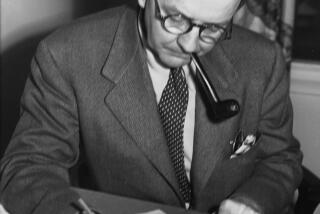Spirit of Hunter S. Thompson lingers at his favorite Colorado bar

Bartender Eric Kincade talks with regulars at the Woody Creek Tavern, a longtime hangout of the writer Hunter S. Thompson.
On most days someone will wander into this rustic little saloon in a lush valley outside Aspen seeking directions to the house of late journalist Hunter S. Thompson.
“I tell them, ‘You know he’s dead, don’t you?’” said Rachael Bannon, a waitress at the Woody Creek Tavern.
These “Hunter hunters” often wear black, smoke cigarettes in slender holders and have “gonzo” tattooed somewhere.
The regulars will smile politely and send them in the wrong direction.
“They’ve even offered me money, but I’ll never tell,” one said.
Ten years after Thompson’s suicide at his nearby Owl Farm home, the bar where he got frightfully drunk, abused drugs and incited mayhem has become a shrine to the writer whose irreverent dispatches on everything from huffing ether outside Vegas to presidential politics created the literary genre known as “gonzo journalism.”
Disciples and fans come to sit where he sat, drink what he drank and revel in a manic life force that lingers a decade later. Walls are adorned with photos of Thompson: He sits in solitary repose over his typewriter or cavorts with actors Johnny Depp and John Cusack. His melancholy portrait hangs near the kitchen, infused with the grease of countless hamburgers.
But while many breeze in on whimsical pilgrimages to commune with some ethereal gonzo spirit, longtime Thompson compatriots remain fiercely protective of their mercurial friend.
“We all miss him,” said a friend who identified himself only as Mike. “Hunter and I were political opposites. I’m a Vietnam vet and we would argue about the war, but it was never personal.”
Mike, 69, with a gray ponytail and a cowboy hat, was the first customer of the day. He sat at the bar and ordered a Corona and six packets of Pall Malls for a friend down the road.
As the beer flowed, Mike told stories about Thompson — guns figured prominently.
“I recall him carrying a shotgun in his golf bag,” Mike said. “I think he threatened to shoot everyone from time to time.”
He also recalled Thompsonmarching through the tavern doors, leveling a gun at the petrified bartender and pulling the trigger. Fortunately, he was shooting blanks. Another time he emptied the place by igniting a smoke bomb.
When he died, his ashes were blasted from a 100-foot cannon.
“That’s why the fishing was so good in the river afterward,” Mike said.
Bartender Eric Kincade fields calls from people around the world asking about Thompson, especially what he drank.
“He liked tequila but he drank everything,” he said.
“I never saw him drink wine,” Mike observed.
“Too dainty?” Kincade asked.
“No, he couldn’t get the cork out of the bottle,” Mike replied.
This is the off-season in the verdant Roaring Fork Valley, that magical interlude between the departure of the skiers and the arrival of summer vacationers. A time when creeks run thick with trout and wobbly colts gain their legs in green pastures.
The mood in the tavern was convivial, helped along perhaps by a dearth of Hunter hunters, who can disrupt the relaxed vibe by badgering locals about their hero.
By midafternoon tables had filled with day laborers beside spandex-clad cyclists, snapping pictures of the weirdly glittering interior with its strings of Christmas lights and tens of thousands of snapshots of Thompson and assorted customers covering every inch of wall space.
A knot of men crowded the bar.
“When Hunter wrote ‘Fear and Loathing in Las Vegas’ he was talking about pursuing the American Dream, and people still react to that. The drugs and booze were part of it,” said a Thompson friend who gave his name only as Steve. “People come in here and they’re all grasping in the sand hoping to find something.”
At the Woody Creek Community Center next door, Thompson’s work occupies its own bookcase.
Once a month his widow, Anita, who still lives at Owl Farm, holds a writing class here as part of her Gonzo Foundation, which promotes Thompson’s literary legacy.
“Gonzo journalism means experiencing the truth of something,” said center director Emily Taylor. “You insert yourself into the story; you aren’t objective.”
Back at the tavern, waitress Paula Sahr scanned a copy of the Aspen Times. She’s been working here on and off since 1990, and knew Thompson well.
“People used to come in to get a glimpse of him; now they come in to get a sense of him,” she said. “The times have definitely changed. It was a different world back then. Behave like that today and you’ll get arrested.”
Beneath Thompson’s studied craziness lay a jarring unpredictability.
“He was cantankerous. You never knew what you were going to get,” said tavern regular Rusty Keasler. “He liked to push people’s buttons.”
On Feb. 20, 2005, Thompson, 67 and in declining health, pushed his own button. He ate a breakfast of fresh fruit and Jello with gin and Grand Marnier splashed on top. Then he put a pistol in his mouth and pulled the trigger.
The shot echoes today.
“I think the tavern has been melancholy ever since,” said Steve at the bar. “It was the end of an era. Hunter’s world no longer exists.”
More to Read
Start your day right
Sign up for Essential California for news, features and recommendations from the L.A. Times and beyond in your inbox six days a week.
You may occasionally receive promotional content from the Los Angeles Times.






